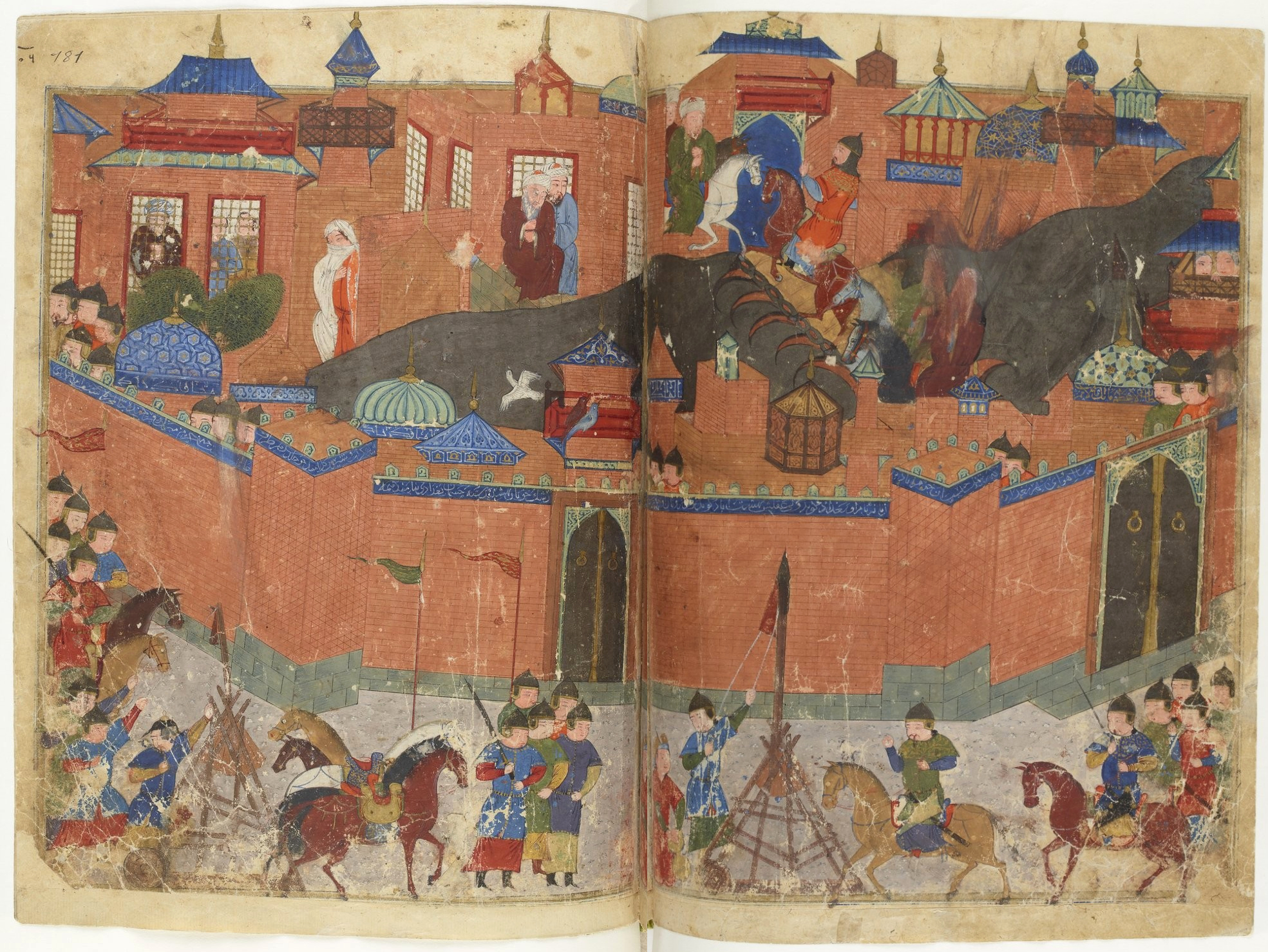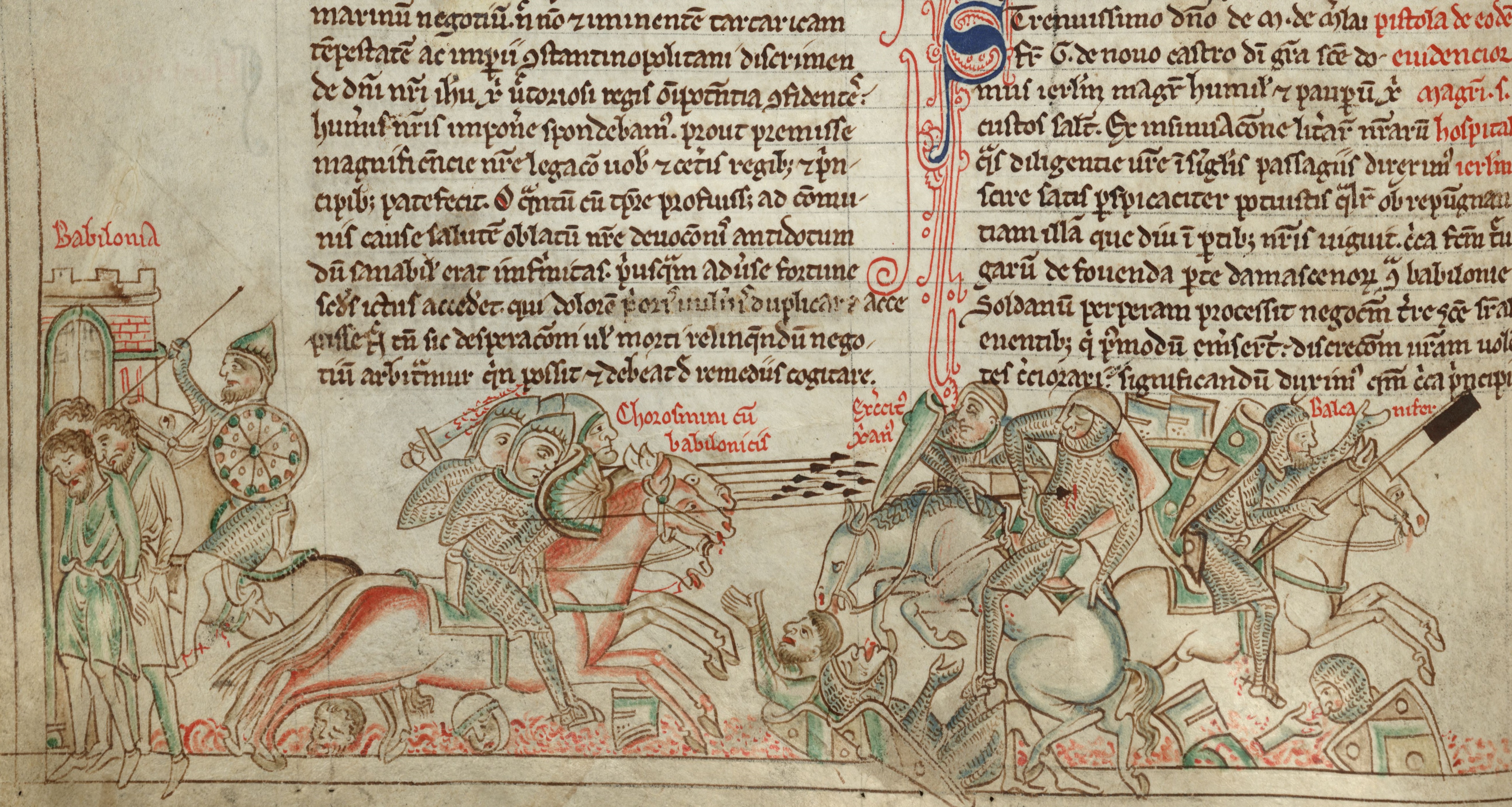|
Qutuz
Sayf ad-Din Qutuz (; died 24 October 1260), also romanized as Kutuz or Kotuz and fully al-Malik al-Muẓaffar Sayf ad-Dīn Quṭuz ( ), was the Mamluk Sultan of Egypt. He reigned as Sultan for less than a year, from 1259 until his assassination in 1260, but served as the ''de facto'' ruler for two decades. Sold into slavery in Egypt, he rose to become vice-sultan for more than 20 years, becoming the power behind the throne. He was prominent in defeating the Seventh Crusade, which invaded Egypt in 1249–1250. When Egypt was threatened by the Mongols in 1259, he took control of the military and deposed the reigning sultan, 15-year-old Sultan Al-Mansur Ali. The Mongols conquered the centers of Islamic power in Syria and Baghdad, and the center of the Islamic Empire moved to Egypt, which became their next target. Qutuz led an Egyptian Mamluk army north to confront the Mongols, who had made a pact with Egypt's long-time enemy, the Crusaders. The Battle of Ain Jalut was foug ... [...More Info...] [...Related Items...] OR: [Wikipedia] [Google] [Baidu] |
Battle Of Ain Jalut
The Battle of Ain Jalut (), also spelled Ayn Jalut, was fought between the Bahri Mamluks of Egypt and the Ilkhanate on 3 September 1260 (25 Ramadan 658 AH) near the spring of Ain Jalut in southeastern Galilee in the Jezreel Valley. It marks as the first major loss of the Mongolian advances and halted their expansion into Arabia and Europe. Continuing the westward expansion of the Ilkhanate, the armies of Hulegu Khan captured and sacked Baghdad in 1258, along with the Ayyubid capital of Damascus sometime later. Hulegu sent envoys to Cairo demanding Qutuz surrender Egypt, to which Qutuz responded by killing the envoys and displaying their heads on the Bab Zuweila gate of Cairo. Shortly after this, Möngke Khan was slain in battle against the Southern Song. Hulegu returned to Mongolia with the bulk of his army to attend the kurultai in accordance with Mongol customs, leaving approximately 10,000 troops west of the Euphrates under the command of Kitbuqa. Learning of t ... [...More Info...] [...Related Items...] OR: [Wikipedia] [Google] [Baidu] |
Baibars
Al-Malik al-Zahir Rukn al-Din Baybars al-Bunduqdari (; 1223/1228 – 1 July 1277), commonly known as Baibars or Baybars () and nicknamed Abu al-Futuh (, ), was the fourth Mamluk sultan of Egypt and Syria, of Turkic Kipchak origin, in the Bahri dynasty, succeeding Qutuz. He was one of the commanders of the Muslim forces that inflicted a defeat on the Seventh Crusade of King Louis IX of France. He also led the vanguard of the Mamluk army at the Battle of Ain Jalut in 1260, which marked the first substantial defeat of the Mongol army and is considered a turning point in history. The reign of Baybars marked the start of an age of Mamluk dominance in the Eastern Mediterranean and solidified the durability of their military system. He managed to pave the way for the end of the Crusader presence in the Levant and reinforced the union of Egypt and Syria as the region's pre-eminent Muslim state, able to fend off threats from both Crusaders and Mongols, and even managed to subdue th ... [...More Info...] [...Related Items...] OR: [Wikipedia] [Google] [Baidu] |
Mamluk Egypt
The Mamluk Sultanate (), also known as Mamluk Egypt or the Mamluk Empire, was a state that ruled Egypt, the Levant and the Hejaz from the mid-13th to early 16th centuries, with Cairo as its capital. It was ruled by a military caste of mamluks (freed slave soldiers) headed by a sultan. The sultanate was established with the overthrow of the Ayyubid dynasty in Egypt in 1250 and was conquered by the Ottoman Empire in 1517. Mamluk history is generally divided into the Turkic or Bahri period (1250–1382) and the Circassian or Burji period (1382–1517), called after the predominant ethnicity or corps of the ruling Mamluks during these respective eras. The first rulers of the sultanate hailed from the mamluk regiments of the Ayyubid sultan as-Salih Ayyub (), usurping power from his successor in 1250. The Mamluks under Sultan Qutuz and Baybars routed the Mongols in 1260, halting their southward expansion. They then conquered or gained suzerainty over the Ayyubids' Syrian prin ... [...More Info...] [...Related Items...] OR: [Wikipedia] [Google] [Baidu] |
Mamluk
Mamluk or Mamaluk (; (singular), , ''mamālīk'' (plural); translated as "one who is owned", meaning "slave") were non-Arab, ethnically diverse (mostly Turkic, Caucasian, Eastern and Southeastern European) enslaved mercenaries, slave-soldiers, and freed slaves who were assigned high-ranking military and administrative duties, serving the ruling Arab and Ottoman dynasties in the Muslim world. The most enduring Mamluk realm was the knightly military class in medieval Egypt, which developed from the ranks of slave-soldiers. Originally the Mamluks were slaves of Turkic origins from the Eurasian Steppe, but the institution of military slavery spread to include Circassians, Abkhazians, Georgians, Armenians, Russians, and Hungarians, as well as peoples from the Balkans such as Albanians, Greeks, and South Slavs (''see'' Saqaliba). They also recruited from the Egyptians. The "Mamluk/Ghulam Phenomenon", as David Ayalon dubbed the creation of the specific warrior class, was ... [...More Info...] [...Related Items...] OR: [Wikipedia] [Google] [Baidu] |
List Of Mamluk Sultans
The following is a list of Mamluk sultans. The Mamluk Sultanate was founded in 1250 by '' mamluks'' of the Ayyubid sultan as-Salih Ayyub and it succeeded the Ayyubid state. It was based in Cairo and for much of its history, the territory of the sultanate spanned Egypt, Syria and parts of Anatolia, Upper Mesopotamia and the Hejaz. The sultanate ended with the advent of the Ottoman Empire in 1517. The Mamluk period is generally divided into two periods, the Bahri and Burji periods. The Bahri sultans were predominantly of Turkic origins, while the Burji sultans were predominantly ethnic Circassians. While the first three Mamluk sultans, Aybak Izz al-Din AybakThe name Aybeg or Aibak or Aybak is a combination of two Turkic words, "Ay" = Moon and "Beg" or variant "Bak" = Emir in Arabic. -(Al-Maqrizi, Note p.463/vol.1 ) () (''epithet:'' al-Malik al-Mu'izz Izz al-Din Aybak al-Jawshangir ..., his son al-Mansur Ali, and Qutuz, are generally considered part of the Bahri dynas ... [...More Info...] [...Related Items...] OR: [Wikipedia] [Google] [Baidu] |
Aybak
Izz al-Din AybakThe name Aybeg or Aibak or Aybak is a combination of two Turkic words, "Ay" = Moon and "Beg" or variant "Bak" = Emir in Arabic. -(Al-Maqrizi, Note p.463/vol.1 ) () (''epithet:'' al-Malik al-Mu'izz Izz al-Din Aybak al-Jawshangir al-Turkmani al-Salihi, ) was the first of the Mamluk sultans of Mamluk Sultanate (Cairo), Egypt in the Turkic peoples, Turkic Bahri dynasty, Bahri line.Though Aybak is regarded by historian as a Mamluk, he actually served in the court of as-Salih Ayyub as an Emir/military commander and not as a Mamluk.- Shayal, p. 153/ vol.2- Al-Maqrizi, p. 463/vol.1 – According to Ibn Taghri as-Salih Ayyub bought him before he became a Sultan and he promoted him to the position an Emir. The rank which Aybak used was of a Khawanja (خوانجا Sultan's accountant ). Ibn Taghri, PP.103-273/ The Sultanate of al-Muizz Aybak al-Turkumani.Some historians, however, consider Shajar Adurr as the first of the Mamluk Sultans. Shayal, p.115/vol.2.Al-Maqrizi, also, ... [...More Info...] [...Related Items...] OR: [Wikipedia] [Google] [Baidu] |
Bahri Dynasty
The Bahri Mamluks (), sometimes referred to as the Bahri dynasty, were the rulers of the Mamluk Sultanate of Egypt from 1250 to 1382, following the Ayyubid dynasty. The members of the Mamluk ruling class were purchased as slaves ( mamluks) and manumitted, with the most powerful among them taking the role of sultan in Cairo. While several Bahri Mamluk sultans tried to establish hereditary dynasties through their sons, these attempts were ultimately unsuccessful, with the role of sultan often passing on to another powerful Mamluk. The Bahri Mamluks were of mostly Kipchak Turkic origin. Fourteen of eighteen sultans between 1279 and 1390 belonged to the Qalawunid lineage. After 1382/1390, they were succeeded by a second Mamluk regime, the Burji Mamluks, who were largely of Circassian origin. The name ''Bahri'' or ''Bahriyya'' means 'of the river', referring to the location of their original barracks on Roda Island in the Nile (''Nahr al-Nil'') in Cairo, at the citadel of Al-Rodah ... [...More Info...] [...Related Items...] OR: [Wikipedia] [Google] [Baidu] |
Al-Mansur Ali
Al-Mansur Ali (, ''epithet'': ''al-Malik al-Manṣūr Nūr ad-dīn ʾAlī ibn Aybak'', Arabic: ) (b. c. 1242) was the second of the Mamluk Sultans of Egypt in the Turkic, or Bahri, line. Some historians, however, consider Shajar al-Durr as the first of the Mamluk Sultans; thus, to them Al-Mansur Ali was the third Mamluk Sultan and not the second.(Shayal, p.115/vol.2.) He ruled from 1257 to 1259 after the assassination of his father Aybak during a turbulent period that witnessed the Mongols invasion of the Islamic world The terms Islamic world and Muslim world commonly refer to the Islamic community, which is also known as the Ummah. This consists of all those who adhere to the religious beliefs, politics, and laws of Islam or to societies in which Islam is .... References Bibliography * Shayal, Jamal, Prof. of Islamic historyTarikh Misr al-Islamiyah(History of Islamic Egypt), dar al-Maref, Cairo 1266, {{DEFAULTSORT:Mansur Ali Bahri sultans Egyptian nobili ... [...More Info...] [...Related Items...] OR: [Wikipedia] [Google] [Baidu] |
Seventh Crusade
The Seventh Crusade (1248–1254) was the first of the two Crusades led by Louis IX of France. Also known as the Crusade of Louis IX to the Holy Land, it aimed to reclaim the Holy Land by attacking Egypt, the main seat of Muslim power in the Near East. The Crusade was conducted in response to setbacks in the Kingdom of Jerusalem, beginning with the loss of the Holy City in 1244, and was preached by Pope Innocent IV, Innocent IV in conjunction with a crusade against Frederick II, crusade against emperor Frederick II, Baltic rebellions and Mongol incursions. After initial success, the crusade ended in defeat, with most of the army – including the king – captured by the Muslims. Following his release, Louis stayed in the Holy Land for four years, doing what he could towards the re-establishment of the kingdom. The struggle between the papacy and Holy Roman Empire paralyzed Europe, with few answering Louis' calls for help following his capture and ransoming. The one answer was th ... [...More Info...] [...Related Items...] OR: [Wikipedia] [Google] [Baidu] |
Crusaders
The Crusades were a series of religious wars initiated, supported, and at times directed by the Papacy during the Middle Ages. The most prominent of these were the campaigns to the Holy Land aimed at reclaiming Jerusalem and its surrounding territories from Muslim rule. Beginning with the First Crusade, which culminated in the capture of Jerusalem in 1099, these expeditions spanned centuries and became a central aspect of European political, religious, and military history. In 1095, after a Byzantine request for aid,Helen J. Nicholson, ''The Crusades'', (Greenwood Publishing, 2004), 6. Pope Urban II proclaimed the first expedition at the Council of Clermont. He encouraged military support for Byzantine emperor AlexiosI Komnenos and called for an armed pilgrimage to Jerusalem. Across all social strata in Western Europe, there was an enthusiastic response. Participants came from all over Europe and had a variety of motivations. These included religious salvation, satisfying ... [...More Info...] [...Related Items...] OR: [Wikipedia] [Google] [Baidu] |





